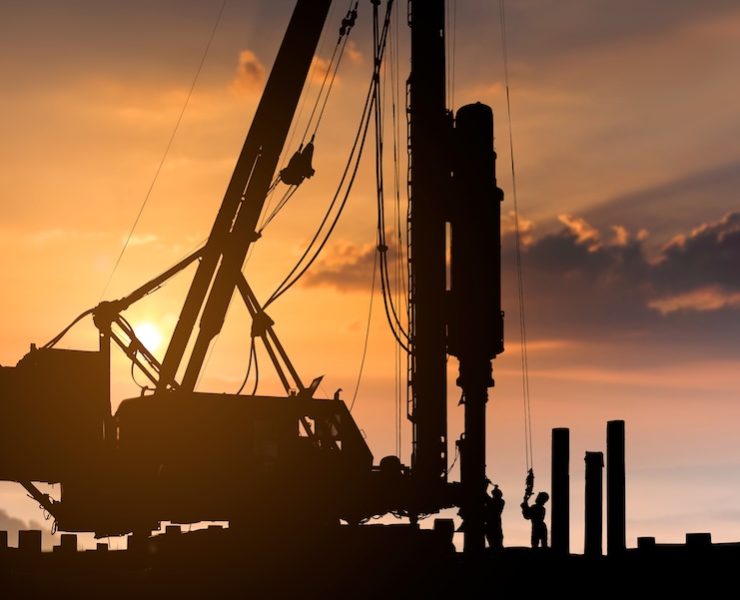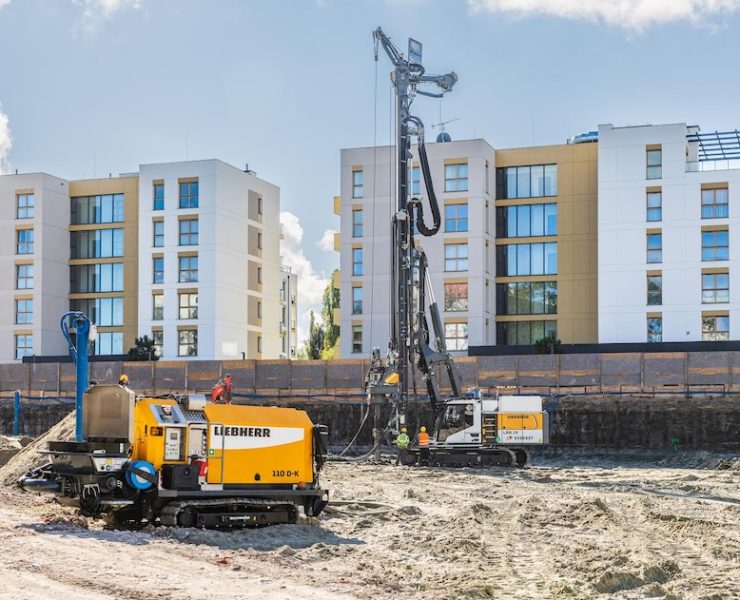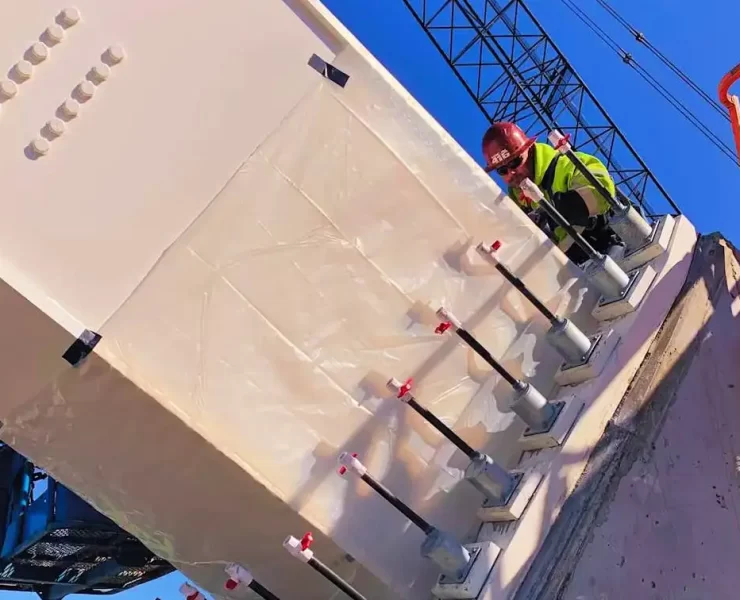Installation of Driven Piles – Inspection, Repair, Load, Transportation, and More
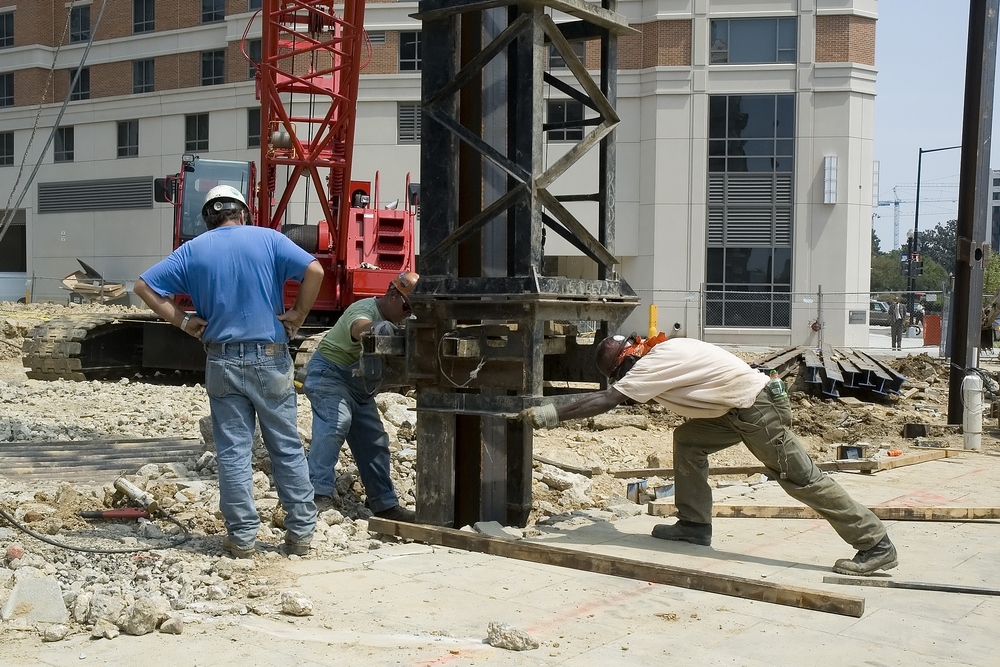

Extensive pre-construction planning is vital to the success and efficiency of pile installation operations.
By analyzing a host of project documents and performing pre-construction site visits, a contractor’s superintendent, along with supervisors, can formulate an overall project plan that specifies all details of a job.
From this plan, the superintendent can then properly schedule a project, from the loading of equipment to the commencement of pile installation operations.
Contract
When reviewing a project’s contract, a superintendent should note any unclear items that may cause a problem down the road, and discuss these concerns with supervisors before work starts.
Analysis of the contract will provide a superintendent with a better understanding of the project’s:
Scope: number of piles and base length or aggregate footage; project timeline
Other Work Items: test piles, load tests, or reinforcing
Payment: method of payment for various work items, provisions for longer or shorter piles, provisions for delay reimbursement, payment of inspections and tests
Assigned Responsibilities: who furnishes the boiler, compressor, drilling, or jetting water; who stakes out piles, maintains stakes, and gives cut-off grades; and who logs piles
Typically, as part of the contract, a project’s specifications should be read and understood. Note that the specifications should have been crafted by someone with technical knowledge of the foundational problems related to the project.
Piling Specifications
- Driving criteria and size of hammer
- Minimum pile length
- Pile type, minimum head, toe, or average diameter
- Hammer cushion specs
- Jetting, spudding, or pre-excavation provisions
- Driving tolerances
- Procedures to follow if pile hits obstruction
- Concrete placing and dewatering requirements
- Testing criteria for pile capacity
- Test pile specs
Material Specifications
- Mix design of concrete materials and strength requirements
- Design and fabrication of precast piles
- Reinforcing steel
- Structural steel or pipe for piles
- Structural timber and wood piles
- Required testing of materials and resulting reports
Plans and Borings
Studying foundational drawings allows a superintendent to check dimensions on piling sketches, and view pier layouts and pile spacing.
Any isolated piles or piles with high or low cut-off elevations cited in the plans should be noted. When eyeing the boring logs, identify the average cut-off elevation and any probable pile toe locations.
Estimate and Data Sheet
The schedules of the estimate and project data sheet provide information related to the number, type, loading, and length of piles. This sheet also includes data related to the planned sequence of driving, the equipment estimated for and planned, and its source.
Compare all data with project plans and specifications, noting any differences that warrant further discussion.
Site Visit
Prior to the commitment of equipment and crew, a superintendent should conduct several site visits that will provide indications as to the work of subcontractors responsible for excavation, sheeting, dewatering, pile staking, and obstruction removal.
The superintendent can also observe access roads, ramps, the rig set-up area, overhead obstructions, adjacent structures requiring special precautions, and underground facilities – while mapping out areas for material storage, temporary buildings, water, and a welding yard.
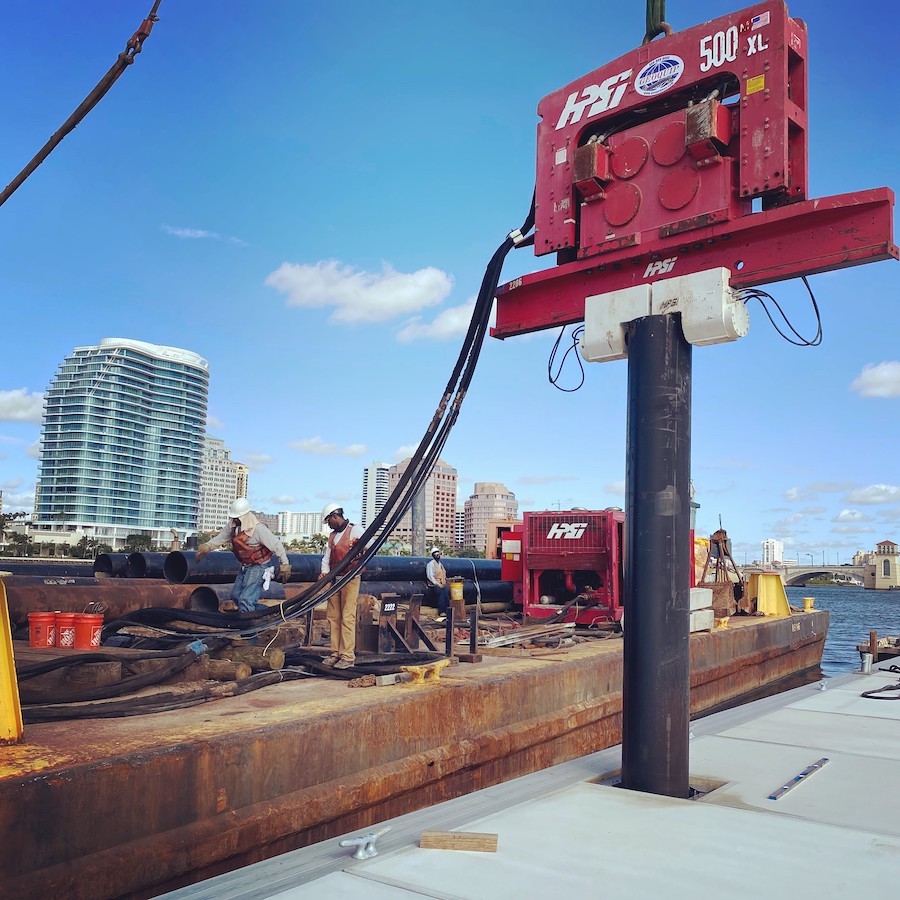
Overall Plan
Having studied the project, the superintendent can better create an in-depth project plan focused on the following categories:
- Schedule and Progress
- Moves On and Off Site
- Rig Moves
- Driving Cycle
- Normal and Unplanned Rig Delays
- Pile Assembly
- Concreting
- Pile Tests
- Special Problems
- Safety, Maintenance, and Unexpected Problems
Establishing an overall plan segues into the scheduling of construction operations, which is back-figured from the date the first pile is driven. The optimum schedule ensures that the rig, materials, and crews come together at the right time.
Timeline of Operations
A scheduling list should be a very step-by-step document with items listed in chronological order. Below is a list of scheduling items in order of occurrence:
- Ensure arrival of office trailer and needed utilities, erect signage at entry, and arrange for mail delivery.
- Notify offices of project address and telephone numbers.
- Set up computer equipment, make provisions for internet connection, and check connection.
- Notify local union of project start date and arrange for crews.
- Obtain phone numbers of general superintendents and those to be contacted in an emergency.
- Ensure arrival of tool boxes, shanties, and light support equipment.
- Set up personnel support facilities.
- If night work will occur, obtain and set up floodlighting.
- Obtain water, fuel, lubricants, air and gas, hand tools, lumber, and other supplies.
- Arrange for permits you’re required to provide.
- Set up unloading facilities, and sheet and welding racks.
- Unload and process pile material.
- Unload mats, cribbing, and timbers.
- Unload and assemble the basic crane, including crawlers and boom.
- If removed for transportation, add counterweight and boiler.
- Assemble leaders, drill, or jet guides.
- Erect leaders.
- Install hammer, core, follower, drills, and jets.
If using stored equipment, a superintendent should also visit the storage site, inspecting the equipment slated for use.
During inspection, check that all pins, bolts, and links are on hand or have been ordered. Additionally, ensure that the equipment is lubricated, painted, and repaired so that it arrives on site in good condition.
Review loading arrangements with the project’s supervisor and a reputable truck driver who is responsible for equipment delivery, ensuring that minimum fuel and tools are required during loading. Next, schedule the arrival of trucks and trailers, or the spotting of rail cars or barge.
Prior to loading, all equipment must be dismantled or separated, as required for transportation. Load out the equipment in the order required at the project site. If this can’t be accomplished, extra trailers will be needed to assure the items can be loaded without re-handling, arriving onsite in the order need for erection.
Additionally, before loading, go over the transportation route with the driver, reviewing exit and route numbers, street names, and landmarks.
During truck transport, maintain contact with the driver and someone at the site. Maintain this contact until the equipment arrives and confirm that the necessary crew will be available for unloading.
If rail transport is utilized, locate the nearest siding for unloading. If delivering equipment by barge, communicate with the towing company – determining the timing and route of the barge.
Before equipment is moved onsite, taking pictures is recommended.
Unloading
Having selected the proper area onsite before transport, unload each piece of equipment along with materials. Remember to always have an alternate site, as the first site may not be usable as the project progresses.
Below are characteristics of a good unloading site:
- Accessible by all-weather roads
- Adequate parking for all vehicles unloading
- Sufficient space for temporary storage of pile material
- Near to the first driven pile
Inspection and Repair
As equipment arrives, a superintendent should check it against his equipment list, inspecting each item to determine if any piece requires major repair or replacement.
It’s important to follow a detailed equipment checklist that includes the following tasks:
- Inspect leaders, spotters, and booms for structural damage.
- Check availability of smaller parts – i.e. pins, bolts, and links.
- Inspect the hammer for loose or worn parts.
- Inspect hydraulic and steam or air hoses, ensuring proper size.
- Check ladders and catwalks.
- Check and lubricate all sheaves.
- Check turntable pad eye locations.
- Inspect boiler, wash, and punch fuses.
- Inspect oil and filters in all hydraulic equipment.
- Inspect the drill.
- Check the auger, bits, and water swivel.
- Inspect cores and check for cracks.
- Check tendons and sockets for wear.
- Locate crane instruction books.
- Ensure that the operator performs all required maintenance on the crane.
- Check the condition of all wire rope.
- Ensure all cables are of proper size and length.
- Check oil and radiator levels in all engines.
- Locate on-hand spares.
- Check the toolbox.
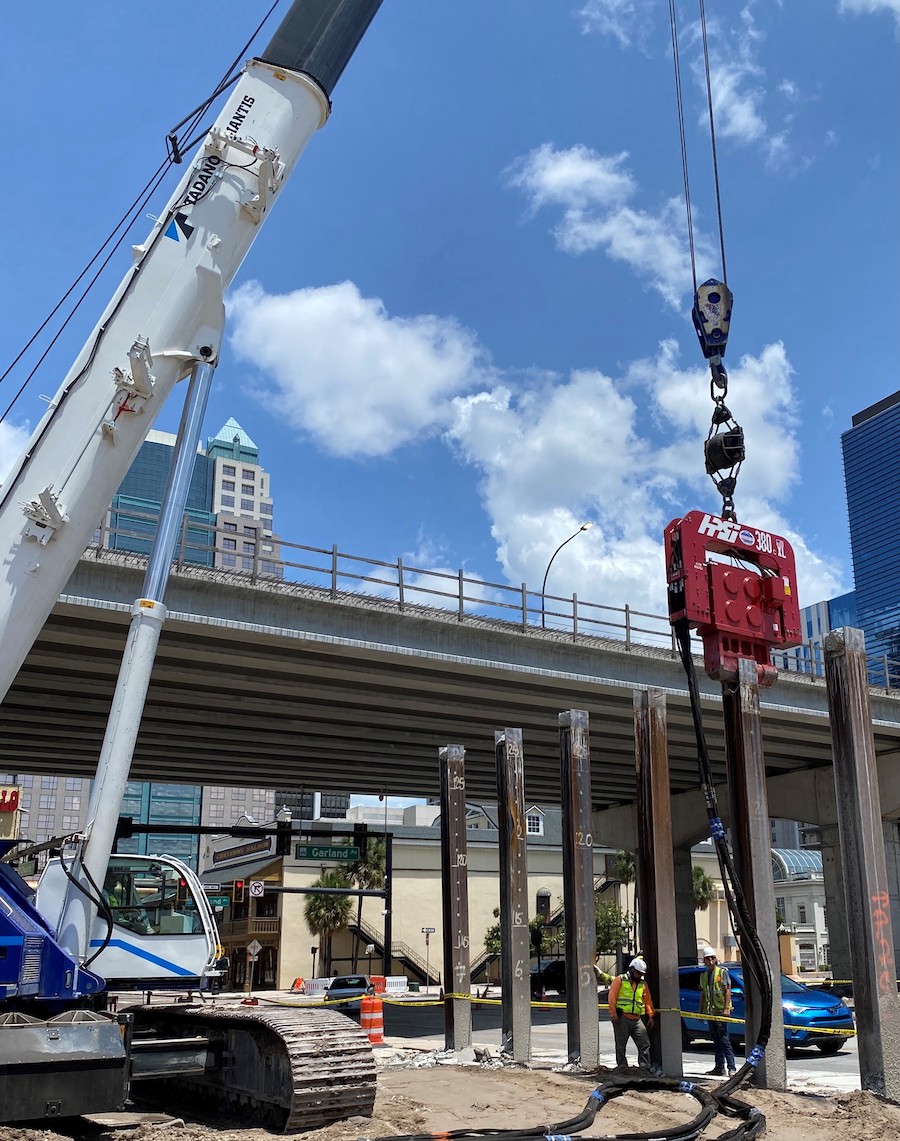
Erection
Assembly of the pile driving rig should occur at the point where driving will initiate, with the goal of erecting the rig effectively in a minimum amount of time.
Assembly entails a host of aspects that must be followed in a specific order, as follows:
- Identify an accessible, level site that will permit assembly of various components, staying away from the edge of excavations.
- Place mats to provide firm support to the rig. Mats under the front edge of the crawlers should receive specific attention, as they should be heavily loaded when leads are raised.
- Walk or unload the crane onto the center of the mats. Crawler sides need to be kept at least five feet back from the edge of any mat.
- If lowered for traveling, raise the gantry to operating position. Attach the boom, counterweight, and boiler in order.
- Assemble sections of leaders alongside the rig on blocking. Ensure the boom-leader connecting pin is under the boom tip, with the bottom end of the leaders slightly to the outside of one crawler.
- Install sliding frame and hammer extensions at the bottom of leaders, and secure them to prevent movement.
- Install drill or jet guides, pile lifting brackets, fairleaders, and other leader hardware. It’s recommended to make an inventory of leader and boom sections, along with hardware, for reference.
- If necessary, arrange for a service crane to assist in raising leaders.
- Lower the boom and connect the clevis of the tapered pin in the leaders to the proper place on the crane boom. Ensure that steam, air, hydraulic, and jet hoses are attached at the boom tip and that the free ends are tied off temporarily alongside the boom.
- Reeve the hammer, drill, and free lines, tying off at the bottom of leaders. Connect a tag line to the bottom of the leaders, enabling control as the leaders clear the ground.
- Raise the boom and leaders. Watch the rear track rollers for lifting. Note: do not add extra counterweight or tie the rear of the rig down.
- Install the spotter and moonbeam, and connect to leaders.
- Connect hydraulic hoses or reeve cable spotters and test operation.
- Reeve the hammer, pick up the hammer, and lower extensions to hold the hammer in leaders. Secure the top of the extensions to the hammer with a short wire rope sling. Install the core head and connect the steam or air hose.
- Install core sections, which are typically picked up with the free line, one at a time, and pinned off to the core head.
- Install drill and auger guides, or jet, and hook up hoses. Raise the drill and connect the auger or drill stem. Test the drill circuit.
- Have a worker go aloft to check for anything that may have loosened during erection.
- Hook up any jet, drilling pumps, or other auxiliary equipment, and test.
- Set the hammer or core on the block and test hammer operation.
Once on site and erected, work can commence, with personal management emerging as a key component to the operation’s success.
The make-up of construction crews can be different depending on the area of the country. In some locales, it may be customary by union agreement to utilize persons in a crew who will perform non-essential takes (i.e. an operator to watch a compressor or welder run).
The pile driver crew is usually established by local agreement, with no additional workers used without consulting a general superintendent. The minimum crew for a crane pile driver consists of a supervisor, an operator, and two drivers. Two additional workers are utilized on the shell rack, when needed.
Additional crews required will vary with the type of pile driven, other work under the contract, and the equipment employed.
All workers must be properly trained to perform their tasks in a safe, timely, and correct manner. The superintendent should identify any improper work habits, ensuring they are corrected quickly and constructively. If urgent, the superintendent may correct or question the orders of a supervisor in front of the crew.
Members of the crew who display leadership abilities should be given the opportunity to utilize their initiative and rotate between projects in order to develop several skills.
When training, while operating a multi-crew project, the less experienced workers should be paired with the most experienced supervisors.
If a superintendent has reason to question a worker’s physical or mental condition, that individual should be examined by a doctor who understands pile-related work. The worker should provide a doctor’s statement prior to returning to work.
As with most workplaces, a good attitude among employees is key to efficient production.
Morale building amenities which contractors can provide onsite include:
- A change trailer with adequate space to hang work clothes and provide shelter from bad weather
- Separate trailers for each craft on large projects
- Properly maintained drinking water and toilet facilities
- Boots, raincoats, and other bad weather gear
- Adequate, well-conditioned tools
- Parking convenient to work area
- Food service
By applying the above pre-construction planning recommendations, a pile contractor can best ensure that project failures stem only from factors that are out of their control. In short, extensive document analysis, site visits, and detailed planning and scheduling are essential to the success of pile installation operations.
What are the essentials to be considered for any successful pile installation operations?
Each pre-project plan should include extensive analysis of the contract, specifications, pre-site visit, and details plan of operation
What are common steps for pile installation process?
1. Pre-project planning 2. Bid contract review and plan 3. Final Drawing Specification and Estimation 4. Site Visit .5. Timeline and Management of Operations 6. Loading and Transportation 7. Crew and Setting up the equipment 8. Installation and Monitoring 9.Post Contruction Review














